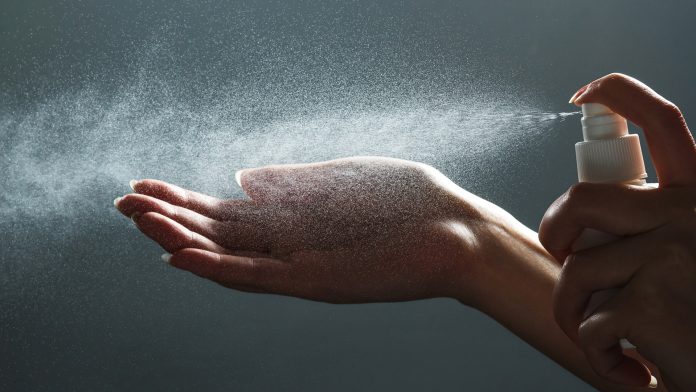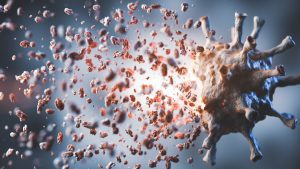
Health Europa examines the ever-growing potential of hypochlorous acid, a miracle antibacterial agent that is safe, strong, and sustainable.
On 24 July 1915, a paper appeared in The British Medical Journal documenting the antiseptic properties of hypochlorous acid, and its efficacy in treating wounds. Although hypochlorous acid was discovered almost 100 years earlier by the French chemist, Antoine Jérôme Balard, it was not until World War I and World War II that it was widely used as an infection control measure in hospitals and to treat field wounds, where medics found soldiers healed in half the time compared to those who received alternative treatments.
Despite its longstanding use as a rapid disinfectant in the medical sector, only relatively recently have the somewhat incomparable benefits of hypochlorous acid been more widely acknowledged with more commercial products entering the household cleaning and skincare markets. But what exactly is this powerful, and all-natural compound, and what opportunities does it present as a safer, non-toxic substitute to traditional antimicrobial products?
What is hypochlorous acid?
Although many of us may not be familiar with hypochlorous acid it is an endogenous substance found in all mammals predominantly tasked with supporting our immunity. It works by engulfing and neutralising invading pathogens through a process called phagocytosis and is shown to be effective against spores, fungi, viruses and bacteria. Composed of hydrogen, oxygen, and chlorine molecules, hypochlorous acid is a weak acid produced by the body’s white blood cells to promote healing and fight infection. Therefore, it is favourable as a topical application due to its non-toxic and non-irritating qualities. Many industries such as hospitality, healthcare, dentistry, and food preparation now use hypochlorous acid solutions as effective cleaning agents.
What makes this disinfectant so appealing as a disinfectant is that compared to other derivatives of the chlorine family, such as sodium hypochlorite (bleach), hypochlorous acid solutions are safe to use and one hundred times more effective at killing harmful viruses when provided in lower concentrations. What is more, because hypochlorous acid is more neutrally charged, it is able to break down the cell wall of negatively charged pathogens and disable them in half the time compared to more aggressive, negatively charged, cleaning agents like bleach. So, given these appealing credentials, why are we only recently seeing the emergence of consumer hypochlorous acid-based products?

Caption: Because hypochlorous acid is more neutrally charged, it is able to break down the cell wall of negatively charged pathogens quicker than negatively charged cleaning agents like bleach
Overcoming the limitations of hypochlorous acid-based products
Until recently, the main quagmire that has limited the widespread uptake of hypochlorous acid-based products is the solution’s instability and short shelf life. Hypochlorous acid was initially produced through electrolysis whereby electrolysed water was widely used in the medical field as a rapid disinfectant, but this soon gave way to more stable and accessible solutions like bleach. Depending on how it is stored, this disinfectant has a typical shelf life of mere hours which for a long time has limited its commercial scope. Thanks to technological advances it is now possible for hypochlorous acid solutions to remain stable for longer periods of time and be produced more cheaply. It must however only be used as a diluted solution and maintain a pH range of between three and six to safeguard its efficacy against harmful pathogens. Likewise, due to its susceptibility to contamination, hypochlorous acid does not bode well when mixed with other chemistries such as fragrance which means there will most likely always be a market for traditional cleaning products.
Hypochlorous acid products are both safe and sustainable
Thanks to advances in electrolysis and manufacturing methods, producing larger, and more stable quantities of the acid have helped to broaden the availability and cost-effectiveness of industrial and consumer products. Diluted hypochlorous acid can be sprayed but also diffused through fogging and misting machines. At the start of the COVID-19 pandemic, the Environmental Protection Association (EPA) approved stabilised hypochlorous acid as a liquid disinfectant and it was deployed through fogging and misting machines to sanitise the public spaces against the SARS-CoV-2 virus. Now, an increasing number of FDA-approved products are making their way onto the consumer market as hypochlorous acid’s positive characteristics as an effective, safe, and environmentally friendly cleanser become increasingly in demand.
In healthcare, hypochlorous acid offers many benefits in pre-and post-operative applications, particularly in wound care and dermatology. Given the challenges around antimicrobial resistance (AMR) and biofilms, hypochlorous-based chemistry could help alleviate reliance on routine antibiotics by offering a quick, non-irritating antiviral solution that simultaneously fights bacteria and promotes cell regeneration.
Viking Pure Solutions: innovating a growing market for hypochlorous acid
In 2020, the global hypochlorous acid market size was $3714.7mn with expected growth to reach $4881.6mn by 2027. As industries become more aware of their environmental footprint, and consumers seek more natural personal care and cleaning products, particularly amid the threat of COVID-19, it is likely that offerings of this popular solution will continue to grow.
Viking Pure Solutions are a major innovator taking the hypochlorous acid market by storm. Using the disinfectant powers of hypochlorous acid, Viking Pure Solutions has developed and refined an all-natural product portfolio. The company prides itself on developing non-toxic, environmentally friendly infection control products that are easily accessible to the healthcare market, revolutionising disinfection measures like never before.
The Viking Pure hypochlorous acid is non-toxic, non-carcinogenic and has a patented salt-free process, making the solution non-corrosive. The disinfectant solution is powerful enough to kill superbugs, which are rapidly becoming a great threat to humankind. On-site generators produce the solution fresh and are ready to be used whenever necessary.
This article is from issue 21 of Health Europa Quarterly. Click here to get your free subscription today.
























